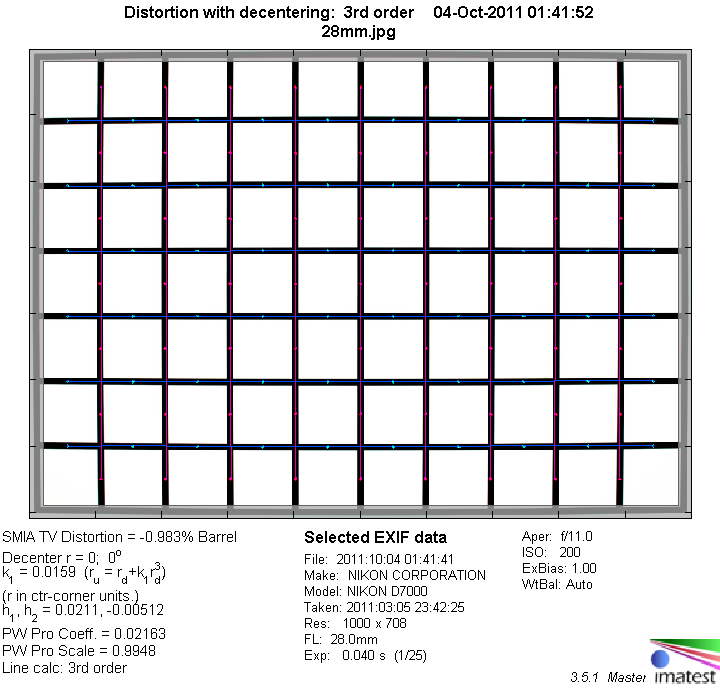|
Page 2 of 2

Distortion
The Zeiss Distagon 28mm f/2 produces a low degree (~1%) of barrel distortion.

The chart above has a real-world size of about 120x80cm.
Vignetting
Even though the small DX sensor cuts off the most critical corners of the lens' image field, vignetting is still quite pronounced wide open. Stopped down just 1 stop (and beyond) light fall-off is no longer an issue, though.

MTF (resolution)
The Distagon delivers very good resolution in the image center wide open. In the aperture range from f/4 to f/8, the sharpness improves to excellent values.
The borders and corners follow a bit behind. Wide open, the borders show good resolution, while the extreme corners are just fair here. Stopping down increases the sharpness here, too. Stopped down to f/4, the borders show very good resolution, at f/5.6 this is also true for the extreme corners.
In our FX review of the lens, the Distagon showed pronounced field curvature with large apertures. On the smaller DX sensor, the critical borders are cut off and field curvature is not really an issue.
Please note that the MTF results are not directly comparable across the different systems!
Below is a simplified summary of the formal findings. The chart shows line widths per picture height (LW/PH) which can be taken as a measure for sharpness.
If you want to know more about the MTF50 figures you may check out the corresponding Imatest Explanations

Chromatic Aberrations (CAs)
Lateral CAs (chromatic aberrations, color shadows at harsh contrast transitions) are moderate at just below 1.5px at the image borders. This may be visible at 100% magnification but it's not really an issue on prints anymore. In addition, it is possible to correct lateral CAs in most modern RAW converters. And any current Nikon DSLR already does this in-camera if you shoot JPG.

Bokeh
Since the lens behaves almost as a normal prime on DX cameras, one of the possible usage scenarios is to seperate the main subject from the background. In such an image the quality of the bokeh (out-of-focus blur) can be of major importance.
The bokeh wide open is a bit nervous. This is not only true for the transition zone, were most lenses struggle, but also for subjects at some distance from the focal plane.
Background highlights retain a circular shape throughout most of the aperture range, except towards the image corners. Due to vignetting they are cut off on one side at f/2. There is a fair amount of outlining wide open as well as some traces of bokeh fringing (which are typical for this lens glass, see next section). Both can be reduced by stopping down. From f/5.6 onwards background highlights begin to develop straight edges. This is not shown here, but visible in one of the sample images in the FX review of the lens (the one with the birch tree).

Bokeh Fringing
Bokeh fringing (non-coinciding focal planes of the various colors) is a common issue with relatively fast glass. As you can
notice below, the halos have different colors - magenta (red + blue) in front the focus point
and green beyond. Truly "apochromatic" lenses don't show bokeh fringing but these lenses are very rare especially
below 100mm. Unlike lateral lateral CAs, bokeh fringing cannot easily be fixed in post processing.
Typical for most fast primes the ZF 28 shows some amount of bokeh fringing at large aperture settings, which can of course be reduced by stopping down. From f/4 onwards, bokeh fringing is no longer field-relevant (except for scenes with very high contrast, which amplifies the issue).
Sample Shots
Full size sample images are available in our FX review of this lens.
VerdictThe Zeiss Distagon T* 28mm f/2 ZF is a stellar performer on FX, however combined with the high resolution DX sensor of the Nikon D7000 it loses some of its sex appeal. The lens is still sharp straight from f/2 in the image center and it reaches excellent quality levels around f/5.6 here. The borders and corners however show quite a bit less sharpness at large apertures. It's however worth noting that, like most Zeiss lenses, the Distagon delivers a very high contrast, even when used wide open.
Lateral and bokeh fringing are moderate and nothing to worry about for most subjects. Distortion is well controlled on a DX camera, vignetting is visible wide open, but no issue stopped down to f/2.8 or beyond. The bokeh is not the most pleasant one, but still ok for a lens in this focal range.
Just like the rest of its family, the Zeiss lens is built to the highest standards. Some users may complain about the lack of AF, but the focus confirmation is available in the viewfinder and in very critical (for example close focus) scenes Live-View can give you the needed guidance.
Since the price level is quite steep, one certainly needs a bit of affection towards high quality manual lenses to justify the expense, at least if the lens is planned to be used on a DX camera only.
|